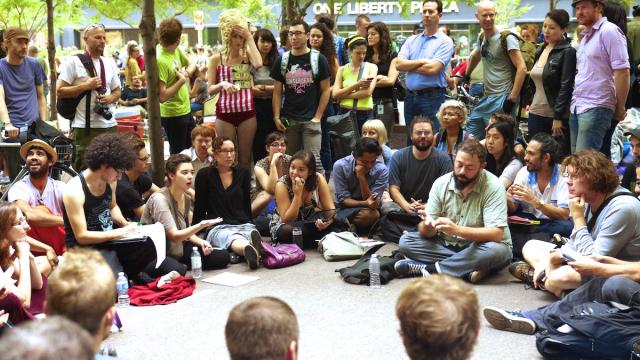
“Collective Thinking is born when we understand that all opinions, be these opinions our own or others', need to be considered when generating consensus and that an idea, once it has been constructed indirectly, can transform us.”– From "On Conflict and Consensus," by C.T. Lawrence Butler
One of the main criticisms that mainstream commentators made about Occupy Wall Street was that the movement didn’t articulate a set list of demands. Seemingly not to comprehend that the occupiers weren't interested in working within the current economic-political model, pundits concentrated their ridicule on the “human mic" and the hand signals that gave voice to the crowd – whether in New York, across the U.S., or in other global cities where Occupy spread in the fall of 2011. That most of these commentators didn’t participate in, nor more than casually observed, the general assemblies that were the fullest expression of the movement was an often neglected part of the story.
For many occupiers, it was a first experience of direct democracy based on the Formal Consensus model, as articulated in the book “On Conflict and Consensus" written by C.T. Butler and Amy Rothstein. Although the model was new to many people, it was actually much easier and faster to teach than the formalities associated with conventional, earlier protocols like Roberts Rules of Order.
One of the main attributes of Formal Consensus is the intention to be non-adversarial, that is, to ignore the traditional “us vs. them” paradigm that has increasingly paralyzed politics, especially in the U.S. Not unique to Occupy, consensus building as a political process has a long history – and movements in Spain, Greece and Chile earlier in 2011 showed how activists could make it function on a larger scale.
The problems of (Formal) Consensus
During Occupy, there was much criticism of “progressive stack,” a technique adopted at Zuccotti Park and elsewhere as the occupations progressed. Progressive stack was enacted in order to deal with one of the main problem created by Formal Consensus: the fact that it can marginalize minority voices. Progressive stack prioritized these voices by moving them to the front of the line, both in working groups and at general assemblies. Those who were prioritized in this way included not only traditionally marginalized groups like African Americans and members of the LGBTQ community, but also people under the age of 18 and older than 35, who were often considered "minority" communities at Occupy Wall Street.
There were many people, even at the occupations themselves, who felt the progressive stack imposed identity politics on the movement and distracted from the larger issue of a tiny elite lording over the other 99% of the population. However, in the years since, we have seen time and again that Occupy lent weight to a range of diverse causes as its participants returned to their communities and reinvigorated activism there once the encampments were taken down. From student debt to Hurricane Sandy to Black Lives Matter, many former occupiers poured their organizing talents and passions into causes that are having real world impact. Much of this enthusiasm was generated by the general assemblies and the use of Formal Consensus.
Another argument that has been made against the Formal Consensus model was that it was too time-consuming. As L.A. Kauffman wrote for Alternet: “In theory, consensus might include everyone in all deliberations, but in practice, the process greatly favored those who could devote limitless time to the movement."
It’s possible that technology can help resolve some of these issues; apps like Loomio could be revolutionary in facilitating Formal Consensus over wide geographic areas in the future. Perhaps, in fact, the next generation of general assemblies could use this type of technology to connect millions and force international institutions and governments to act on widespread concerns like global warming.
Approval voting: An alternative to Formal Consensus?
There are other systems that can be used in lieu of Formal Consensus. One option is approval voting, which could be easily adapted to pass resolutions instead of electing individuals into leadership roles. One of its main virtues is its simplicity.
In traditional approval voting, when more than two candidates are running for election, voters get to choose whether they approve or disapprove of each individual candidate, and all votes count. The winning candidate (or resolution) is the one with the most approval votes. No doubt, in most cases, hand signals could be adapted for approving or disapproving resolutions put before a General Assembly rather than using paper ballots.
Approval voting could be useful dealing with disruptive individuals and agents provocateurs – those who make even the 90% consensus model adopted at Zuccotti Park unworkable. It also offers an efficient way to make decisions more quickly so that people with less time will be more easily able to contribute to the decision making process, especially when immediate action is required.
This is not to say that approval voting should be seen as a replacement for Formal Consensus; in some cases it might work better, in others it might be used alongside it. As the days of Occupy fade further into memory, we have a chance still to highlight some of the movement’s successes as well as its failures. While Formal Consensus should be seen as the former, it isn't necessarily ideal for every situation, or issue. Activists must remember this or risk promoting process over the bigger, actual goals of the movement.
An edited version of this article appeared on Nation of Change.
3 WAYS TO SHOW YOUR SUPPORT
- Log in to post comments











